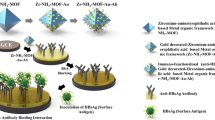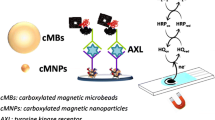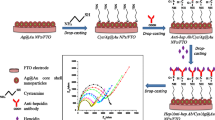Abstract
The authors describe a nanocomposite that was obtained by in-situ deposition of CdS nanocrystals on mesoporous silica nanospheres (MSNs), and its use in an electrochemical immunoassay of human immunoglobulin G (HIgG). The MCN/CdS nanocomposite was covalently modified with the antibodies against HIgG and then employed in a voltammetric immunoassay at antibody-functionalized magnetic beads. Through sandwich immunoreaction, the MCN/CdS nanoprobes are quantitatively captured onto the magnetic beads where numerous Cd(II) ions are released in an acidic solution. The Cd(II) can be detected by anodic stripping voltammetry at a typical working potential of −0.78 V (vs. Ag/AgCl). In combination with the high loading of CdS on MSNs, the use of the stripping voltammetric analysis renders the method high sensitivity. A wide linear range varying from 0.01 to 100 ng mL−1 is obtained for HIgG detection with a lower detection limit at 2.9 pg mL−1. In addition, the preparation of the nanoprobe is inexpensive. The magnetic bead-based assay does not require complex manipulations. Therefore, this method is deemed to possess a wide scope in that it may be applied to other immunoassays.

Schematic presentation of the preparation of the mesoporous silica nanosphere (MSN)/CdS nanocomposite for the electrochemical immunoassay of human IgG at magnetic beads. The high decoration of CdS on MSN and the stripping voltammetric analysis of Cd(II) ions render the method high sensitivity.





Similar content being viewed by others
References
Chen L, Lv S, Gao Z, Chen C (2017) Voltammetric immunoassay for the carcinoembryonic antigen by using a glassy carbon electrode modified with poly(3,4-ethylenedioxythiophene) doped with tannic acid and grafted with poly (ethylene glycol). Microchim Acta 184:4705–4712
Gao H, Wang X, Li M, Qi H, Gao Q, Zhang C (2017) Proximity hybridization-regulated electrogenerated chemiluminescence bioassay of α-fetoprotein via target-induced quenching mechanism. Biosens Bioelectron 98:62–67
Li B, Lai G, Lin B, Yu A, Yang N (2018) Enzyme-induced biomineralization of cupric subcarbonate for ultrasensitive colorimetric immunosensing of carcinoembryonic antigen. Sensors Actuators B Chem 262:789–795
Wan Y, Su Y, Zhu X, Liu G, Fan C (2013) Development of electrochemical immunosensors towards point of care diagnostics. Biosens Bioelectron 47:1–11
Shan J, Ma Z (2017) A review on amperometric immunoassays for tumor markers based on the use of hybrid materials consisting of conducting polymers and noble metal nanomaterials. Microchim Acta 184:969–979
Tang Z, Ma Z (2017) Multiple functional strategies for amplifying sensitivity of amperometric immunoassay for tumor markers: a review. Biosens Bioelectron 98:100–112
Pei X, Zhang B, Tang J, Liu B, Lai W, Tang D (2013) Sandwich-type immunosensors and immunoassays exploiting nanostructure labels: a review. Anal Chim Acta 758:1–18
Du D, Wang L, Shao Y, Wang J, Engelhard MH, Lin Y (2011) Functionalized graphene oxide as a nanocarrier in a multienzyme labeling amplification strategy for ultrasensitive electrochemical immunoassay of phosphorylated p53 (S392). Anal Chem 83:746–752
Xu Q, Wang L, Lei J, Deng S, Ju H (2013) Platinum nanodendrite functionalized graphene nanosheets as a non-enzymatic label for electrochemical immunosensing. J Mater Chem B 1:5347–5352
Lai G, Zhang H, Tamanna T, Yu A (2014) Ultrasensitive immunoassay based on electrochemical measurement of enzymatically produced polyaniline. Anal Chem 86:1789–1793
Yang J, Wen W, Zhang X, Wang S (2015) Electrochemical immunosensor for the prostate specific antigen detection based on carbon nanotube and gold nanoparticle amplification strategy. Microchim Acta 182:1855–1861
Tang D, Yuan R, Chai Y (2008) Ultrasensitive electrochemical immunosensor for clinical immunoassay using thionine-doped magnetic gold nanospheres as labels and horseradish peroxidase as enhancer. Anal Chem 80:1582–1588
Xu Q, Yan F, Lei J, Leng C, Ju H (2012) Disposable electrochemical immunosensor by using carbon sphere/gold nanoparticle composites as labels for signal amplification. Chem Eur J 18:4994–4998
Yang M, Li H, Javadi A, Gong S (2010) Multifunctional mesoporous silica nanoparticles as labels for the preparation of ultrasensitive electrochemical immunosensors. Biomaterials 31:3281–3286
Lu J, Liu S, Ge S, Yan M, Yu J, Hu X (2012) Ultrasensitive electrochemical immunosensor based on au nanoparticles dotted carbon nanotube-graphene composite and functionalized mesoporous materials. Biosens Bioelectron 33:29–35
Cui Z, Cai Y, Wu D, Yu H, Li Y, Mao K, Wang H, Fan H, Wei Q, Du B (2012) An ultrasensitive electrochemical immunosensor for the detection of salbutamol based on Pd@SBA-15 and ionic liquid. Electrochim Acta 69:79–85
Ma H, Mao K, Li H, Wu D, Zhang Y, Du B, Wei Q (2013) Ultrasensitive multiplexed immunosensors for the simultaneous determination of endocrine disrupting compounds using Pt@SBA-15 as a non-enzymatic label. J Mater Chem B 1:5137–5142
Medintz IL, Uyeda HT, Goldman ER, Mattoussi H (2005) Quantum dot bioconjugates for imaging, labelling and sensing. Nat Mater 4:435–446
Tu MC, Chang YT, Kang YT, Chang HY, Chang P, Yew TR (2012) A quantum dot-based optical immunosensor for human serum albumin detection. Biosens Bioelectron 34:286–290
Li XY, Wang RY, Zhang XL (2011) Electrochemiluminescence immunoassay at a nanoporous gold leaf electrode and using CdTe quantun dots as labels. Microchim Acta 172:285–290
Zhao WW, Ma ZY, Yan DY, Xu JJ, Chen HY (2012) In situ enzymatic ascorbic acid production as electron donor for CdS quantum dots equipped TiO2 nanotubes: a general and efficient approach for new photoelectrochemical immunoassay. Anal Chem 84:10518–10521
Liu G, Wang J, Kim J, Jan MR (2004) Electrochemical coding for multiplexed immunoassays of proteins. Anal Chem 76:7126–7130
Chen L, Chen C, Li R, Li Y, Liu S (2009) CdTe quantum dot functionalized silica nanosphere labels for ultrasensitive detection of biomarker. Chem Commun (19):2670–2672
Shiddiky MJA, Rauf S, Kithva PH, Trau M (2012) Graphene/quantum dot bionanoconjugates as signal amplifiers in stripping voltammetric detection of EpCAM biomarkers. Biosens Bioelectron 35:251–257
Reiss P, Carrière M, Lincheneau C, Vaure L, Tamang S (2016) Synthesis of semiconductor nanocrystals, focusing on nontoxic and earth-abundant materials. Chem Rev 116:10731–10819
Han E, Ding L, Jin S, Ju H (2011) Electrochemiluminescent biosensing of carbohydrate-functionalized CdS nanocomposites for in situ label-free analysis of cell surface carbohydrate. Biosens Bioelectron 26:2500–2505
Cao A, Liu Z, Chu S, Wu M, Ye Z, Cai Z, Chang Y, Wang S, Gong Q, Liu Y (2010) A facile one-step method to produce graphene–CdS quantum dot nanocomposites as promising optoelectronic materials. Adv Mater 22:103–106
Xiong J, Wang W, Zhou Y, Kong W, Wang Z, Fu Z (2016) Ultra-sensitive chemiluminescent detection of Staphylococcus aureus based on competitive binding of Staphylococcus protein A-modified magnetic beads to immunoglobulin G. Microchim Acta 183:15073–11512
Lai G, Zhang H, Yu A, Ju H (2015) In situ deposition of Prussian blue on mesoporous carbon nanosphere for sensitive electrochemical immunoassay. Biosens Bioelectron 74:660–665
Peng Y, Xie Y, Luo J, Nie L, Chen Y, Chen L, Du S, Zhang Z (2010) Molecularly imprinted polymer layer-coated silica nanoparticles toward dispersive solid-phase extraction of trace sulfonylurea herbicides from soil and crop samples. Anal Chim Acta 674:190–200
Wang J, Lu J, Hocevar SB, Farias PAM (2000) Bismuth-coated carbon electrodes for anodic stripping voltammetry. Anal Chem 72:3218–3222
Wang J (2005) Stripping analysis at bismuth electrodes: a review. Electroanalysis17:1341–1346
Lai G, Zhang H, Yong J, Yu A (2013) In situ deposition of gold nanoparticles on polydopamine functionalized silica nanosphere for ultrasensitive nonenzymatic electrochemical immunoassay. Biosens Bioelectron 47:178–183
Zhao Y, Zheng Y, Kong R, Xia L, Qu F (2015) Ultrasensitive electrochemical immunosensor based on horseradish peroxidase (HRP)-loaded silica-poly (acrylic acid) brushes for protein biomarker detection. Biosens Bioelectron 75:383–388
Dong S, Tong M, Zhang D, Huang T (2017) The strategy of nitrite and immunoassay human IgG biosensors based on ZnO@ZIF-8 and ionic liquid composite film. Sensors Actuators B Chem 251:650–657
Acknowledgements
This work was financially supported by the National Natural Science Foundation of China (21475033), Science and Technology Foundation for Excellent Creative Research Group of Hubei Provincial Department of Education (T201810), and Open Fund of Hubei Key Laboratory of Pollutant Analysis and Reuse Technology (PA20170207).
Author information
Authors and Affiliations
Corresponding author
Ethics declarations
The authors declare that they have no competing interests.
Additional information
Publisher’s Note
Springer Nature remains neutral with regard to jurisdictional claims in published maps and institutional affiliations.
Electronic supplementary material
ESM 1
(DOC 320 kb)
Rights and permissions
About this article
Cite this article
Guo, P., Wang, Y., Chen, Z. et al. Voltammetric immunoassay of human IgG based on the release of cadmium(II) from CdS nanocrystals deposited on mesoporous silica nanospheres. Microchim Acta 186, 15 (2019). https://doi.org/10.1007/s00604-018-3142-6
Received:
Accepted:
Published:
DOI: https://doi.org/10.1007/s00604-018-3142-6




